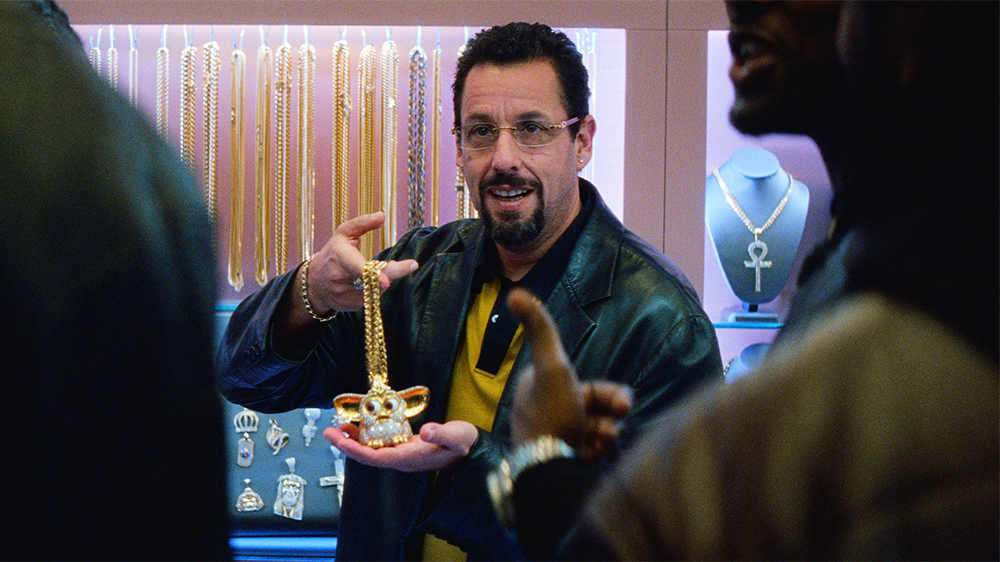"Uncut Gems:" An Anxiety-Ridden Journey of Self-Destruction
Gallery

“Uncut Gems” opens in the sultry rock mines of Ethiopia, where two miners take advantage of an accident that occurs on sight to go and dig out a black opal, a rare and beautiful gemstone embedded in rock that radiates light throughout its prisms to create the illusion of depth through a vast array of colors. The end result is akin to looking at a microscope and discovering a field of vibrant cluster galaxies. As the miners look at the glamorous treasure they’ve unearthed, the camera zooms into the opal’s prisms. Slowly, the luminescent and geological innards of the opal start to become more biological. Blood replaces crystal, flesh replaces mineral, and suddenly we find ourselves inside the body of Howard Ratner, the film’s protagonist, in the middle of a colonoscopy. We’ve traversed through an iridescent geological beauty and have somehow ended up inside the depths of a man’s bowels.
This opening sequence encompasses many of the anti-materialist themes that can be found in “Uncut Gems,” a film that is as sickening as it is enthralling. “Uncut Gems” tells the story of a New York City jeweler, Ratner, a man plagued by a self destructive tendency to gamble everything he has in search of the next big score. This attitude has plummeted him down a chasm of unpaid debts and fractured relationships. Unfortunately for Howard, three loan sharks decide they’ve had enough, and their pursuit sends him on a cat and mouse game across New York City’s seedy underbelly.
What will attract most people to the film is the fact that Howard is played by Adam Sandler, an actor better known for his inclination towards writing and starring in juvenile comedies, such as the horrid “Grown Ups 2” and embarrassing “Jack and Jill.” Here, however, Sandler gives the best performance of his entire career, an Oscar-worthy attempt to humanize one of the most aggravating and unlikeable characters in film history. The character of Howard is one that constantly frustrates the audience as he embarks on a seemingly never ending quest of emotional manipulation and bad decision making. And yet, Sandler somehow manages to give the character a certain charm that, despite his flaws, still makes the audience root for him. We want to see Howard succeed, even though we know he probably never will due to his maniacally selfish state of mind.
Aside from Sandler, most of the film’s cast is populated by non-actors. Julia Fox, for instance, gives a fantastic and frenetic performance in her debut role as Howard’s mistress, Julia, a woman as damaged as she is audacious. Kevin Garnett, known as one of the greatest basketball players of all time, plays an intense and heightened version of himself with brilliant self awareness and unhinged energy. Even the film’s main antagonist, Phil, a loan shark played by the then-unknown Keith Williams Richards (who was apparently cast after being spotted in a NYC subway based off his looks alone), harkens back to the great villainous roles of 1970’s mob movies with his violent and imposing nature.
Josh and Benny Safdie, the directors and writers of the film, instill an incredible sense of genuine grit and realism through their fly-on-the-wall approach to filmmaking. With the help of Darius Khondji, the cinematographer of the film, New York City has never looked more visceral. From neon drenched nightclubs to decadent Manhattan apartments, a sense of frenzy constantly overwhelms the screen through the Safdie’s direction and Khondji’s command of the camera. Along with a chaotically surreal score by Daniel Lopatin, consisting of 80’s influenced synths and New Age choral arrangements, “Uncut Gems” is an experience that can only be described as anxiety-inducing, and solely works because of the fantastic talent working behind the scenes. One can only hope that this isn’t the last collaboration between the Safdie brothers and Sandler, as they’ve proven themselves to be a match made in filmmaking heaven.
